Since we are approaching Christmas at light speed, I’ve decided to write an article which have nothing to do with Christmas or with the month of December for that matter. I will however go back to this French legend:
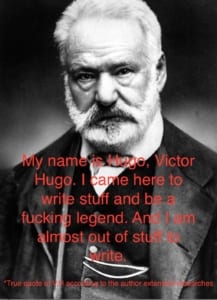
You will never see the end of him!
Some of you might remember my article about the 2012 movie Les Miserables, where I explained my nationally shared contempt for an adaptation. Well, I have decided to talk about another American take on one of Victor Hugo’s classics: Disney’s The Hunchback of Notre Dame.
You have probably started to shiver: What does this French complainer has to say this time? Well, first, French and complainer are redundant and, second, I have (mostly) nothing bad to say about it. I love this movie! It’s in my top 5 favorite Disney’s!
So what is different? Why do I have no positive felling toward les Mis while I can rewatch The Hunchback of Notre Dame every year (besides the obvious fact that I watched the Hunchback of Notre Dame before reading the book)? Because, let’s be real, Disney’s movie is not a good adaptation of the original book.
You, who came for an adaptation of Notre Dame de Paris, go back where you came from
Well let’s make this clear now: when talking about the book I, will use the French name Notre Dame de Paris and while talking about the Disney I will use The Hunchback of Notre Dame (shortened to “THND”). No judgement from me in there—just an easy way to immediately differentiate the two.
In my Les Mis piece, I focused largely on the characters and how they differed from their book counterparts as a way of showing how misadpated the original story was. Even if it’s a bit different for Notre Dame de Paris (Victor Hugo was telling a different story), let’s see who is in character and who isn’t:
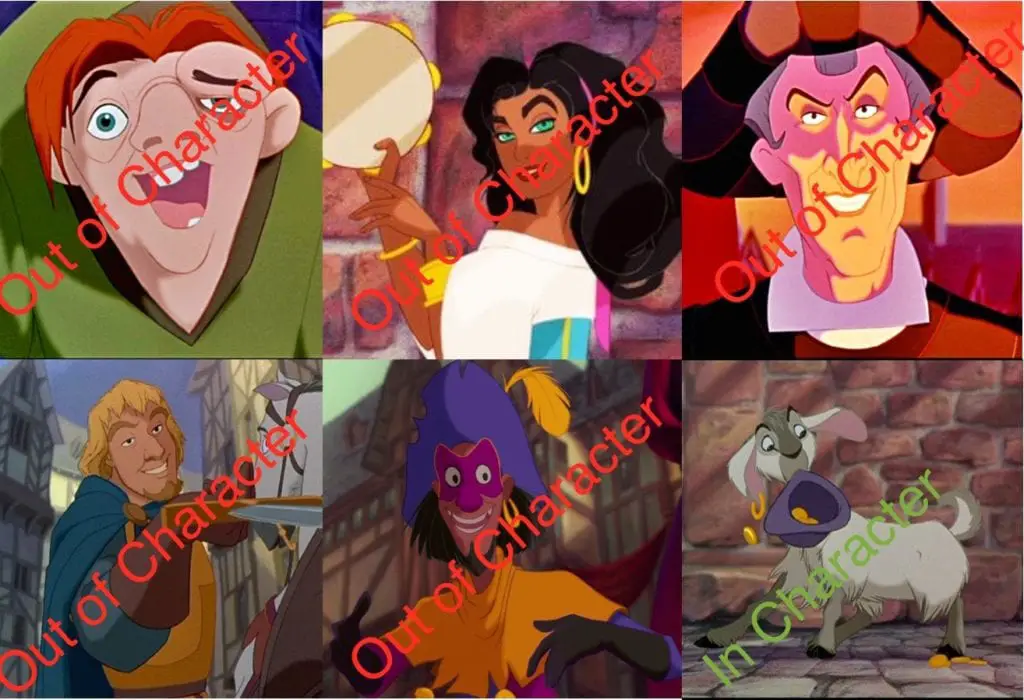
I will not be talking about the characters who were cut from THND (RIP Pierre Gringoire, you will be missed). So…yeah, Disney got the goat right. That’s a good thing I guess. And, yes, it’s even worse with actual story.
Let’s start with what was right: Quasimodo is indeed the Bell Ringer of Notre Dame in Middle Age Paris thanks to Frollo. He is an hunchback, from a gypsy family. Esmeralda is a gypsy dancer and Clopin is the leader of the Court of Miracles. Claude Frollo is sexually obsessed by Esmeralda and it will lead him towards a self-destructive path. Esmeralda and Phoebus have the hots for each other. And there is a Charivari and siege on Notre Dame. But that’s all.
The rest of the story of Notre Dame de Paris is entirely lost in THND, especially since their ends couldn’t be more different. In the book, Victor Hugo meticulously kills all of his characters (because Fatality end of century and all that—we take that pretty seriously in France). In the movie, Good triumphs over Evil and all is well in the best (possible) world. Night and Day, I tell you.
And don’t get me started on the anachronisms. Which might sound nit-picky for Disney, but I don’t just mean the ones done for the fun. Frollo pretty much rules Paris? Under Louis XI, the universal spider, rule? I think not, thank you very much.
Common themes
Let me tell you a secret (which is not a secret because Victor Hugo talks about it in the book’s preface; jeeze, guy, can you let your readers do a bit of work by themselves!): Notre Dame de Paris is before everything else, an architectural treatise. Mr Hugo didn’t like what the architects of his time were doing, and he wrote a novel set in Middle-Age Paris to show how much dignified the city was back then. So next time you think you are over-reacting while writing a 4000 words article about a TV-show, remember that a guy in the 19th century wrote a 500 pages book about medieval Paris with all his OC’s and favorite imagries because he didn’t like how La Bourse looked. AND it’s become a timeless classic.
And that’s why I don’t like the English translations of the title—The Hunchback of Notre Dame—as if Quasimodo was the main character. He is not; the cathedral is. And therefore the cathedral and the architecture should be personified and glorified. That’s what is done in Disney’s THND , even more with the music composed by Alan Menken, which was also heavily inspired by religious music.
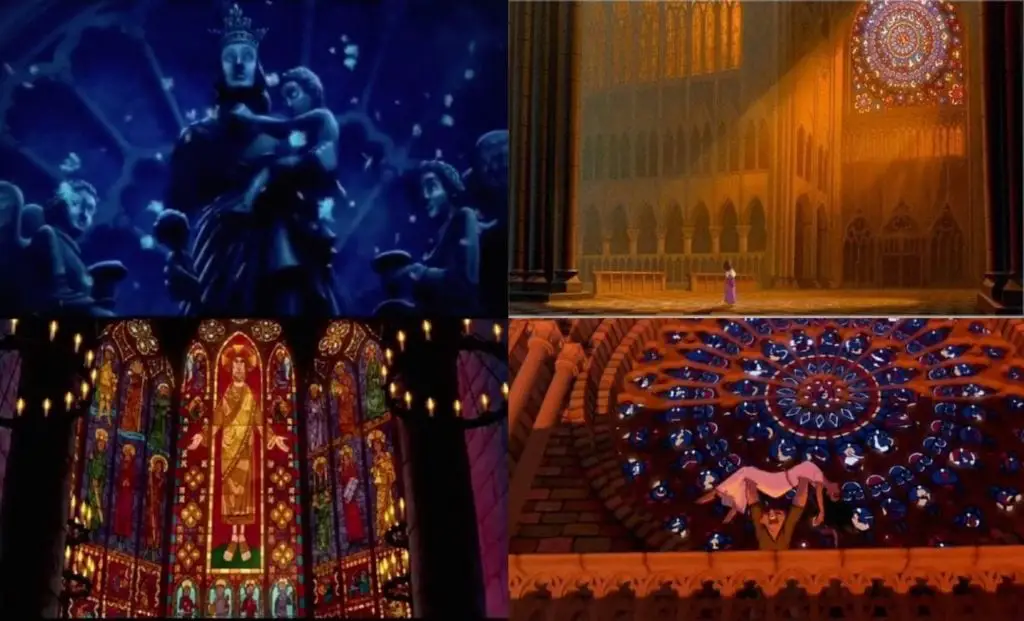
But that’s not the only theme of the book. Victor Hugo couldn’t help himself and always added societal commentary (Victor Hugo…first SJW?). So according to my edition, here are the principal themes:
- Medieval Paris
- The Cathedral
- The progress through printing
- Fatality
- Power and desire
- Fight between Good and Evil
- Monstrosity mixed with beauty
- Love
- Marginality
- Monster
- The people.
So expect for progress and fatality that I don’t see, let’s have look about the others found within in THND.
Power and desire
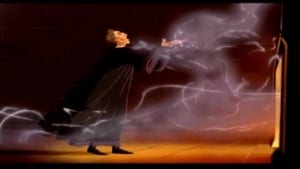
Check.
Fight between Good and Evil
I mean… This is a Disney; this is like a mandatory theme for them. The fact they made Phoebus a good guy and eviled-up Frollo to turn him into a villain that is defeated by the end is kinda telling. Isn’t it?
Monstrosity mixed with Beauty
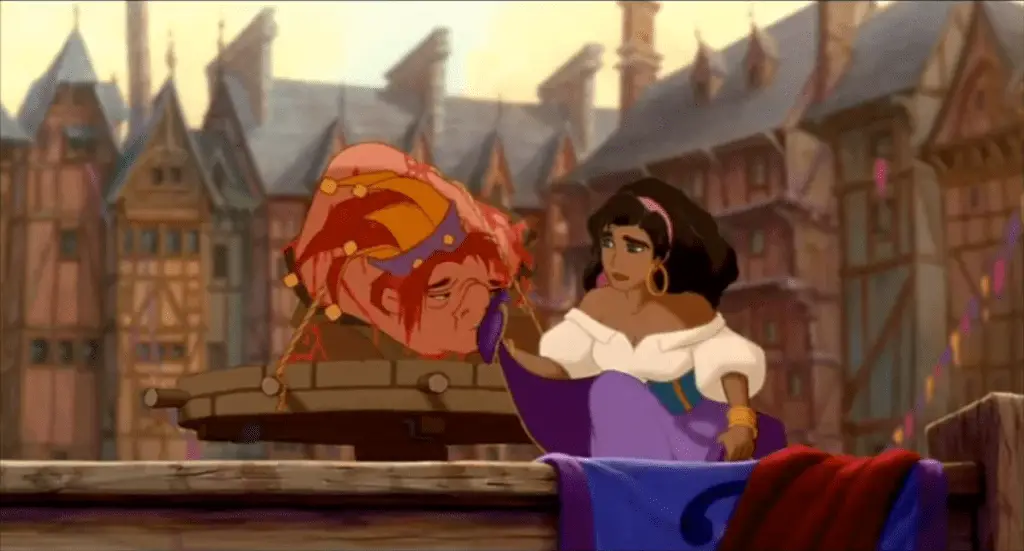
Check!
Love
Well there is the love in this movie. A lot of different types of love, even. Esmeralda and Phoebus end up together. I am especially fond of the relationship between Esmeralda and Quasimodo. It could have easily turned out as a bitter, unrequited love, but it actually proves that romantic interest isn’t the only important relationship that you could look for in your life, even if the two people in the relationship are a man and a woman.
It’s also one of the first Disney films to tackles the subject of of abusive love/fake love and its destructiveness. So yeah, love and its different forms are very important in this movie.
Marginality
Here are an extract from the lyrics of “God Help the Outcasts” (if the title of the song wasn’t telling enough):
God help the outcasts
Hungry from birth
Show them the mercy
They don’t find on earth
God help my people
We look to You still
God help the outcasts
Or nobody will
See where I am going there?
Monster
Well, the movie is centered around the figure of Quasimodo, the Hunchback, so what makes a “monster” is a pretty important part of the movie. As more evidence, here’s part of the opening song “The Bells of Notre Dame”:
Now here is a riddle to guess if you can
Sing the bells of Notre Dame
Who is the monster and who is the man?
The People
The people of Paris, gypsies or not, are omnipresent in this movie. For good and for bad. They are responsible for Quasimodo’s abuse but are really chocked by Esmeralda trials (they are as volatile as they are in Notre Dame de Paris). They suffer abuses at the hand of Frollo. They are a character in this story and that’s not very common in Disney’s movies.
So, when you have finished watching this movie, you have the impression that the people who have written/directed it may have indeed read the original book and understood it.
It’s not an adaptation
This is the thing, yes the team behind THND have read the book, and yes they have understood it. But they decided not to adapt it. They instead decided to use a premise that they liked, and wrote a different story with its own values. A Disney’s story, where Good triumphs over Evil, and where good people are recognized as such and rewarded.
It’s far away from Victor Hugo’s original idea but it’s not less deserving. My favorite theater play is The Trojan War Will Not Take Place by Jean Giraudoux. It’s not a theatrical adaptation of Homer’s Illiad; it’s a story using the setting and the characters of Illiad in order to carry another message. This isn’t a new thing, especially in French theater. Nobody thinks about criticizing the play for that, and I don’t see why we should criticize THND.
Whatever your thoughts on THND (you can dislike a good movie or even like a bad movie…all our faves are problematic), you can’t deny its qualities. The artistic direction is on point, the music is beautiful—this movie has the best intro of any Disney (fight me on that!)—and the characters are interesting (I actually prefer Esmeralda in THBN than in Notre Dame de Paris).
The team behind it was obviously passionate about this project and they created a family movie (maybe not for young children) that tackles difficult subjects and doesn’t take children for idiots.
A movie after my heart indeed.

